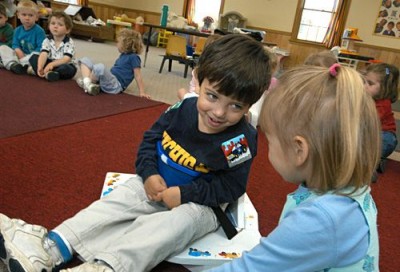While talking to someone with a strong background in speech pathology and literacy recently, I learned of an interesting theory: Inclusion for special-education students, this educator said, has “backfired.”
Now, she didn’t necessarily mean that special-education students should be quarantined from their peers or that the inclusion movement didn’t have good intentions — just that there have been some unexpected consequences since we’ve moved toward inclusion.

Samuel Habib, about whom the 2008 documentary "Including Samuel" was made, sits in his supportive corner chair and smiles at a friend at Shaker Road School in Concord, NH. (Photo courtesy of Dan Habib)
One of the biggest unforeseen effects is that students with special needs who spend the majority of their time in a general-education classroom — over half of the six million U.S. students with disabilities — are spending hours every day with a teacher who likely knows little about how best to teach them. Special-ed students might be mainstreamed with their peers now, but whether they’re getting a better, or even equivalent, education than before isn’t clear.
While others might not go so far as to say the whole model has backfired, many experts are concerned. In fact, while doing research for a recent article about emergency-certification programs for special-education teachers, I found myself having the same conversation with expert after expert. Yes, these emergency-certification programs were of serious concern to them, but of equal or greater concern to them was how few general-education teachers are prepared to work with the special-education students they’ll inevitably have in their classrooms.
The Individuals with Disabilities Education Act (IDEA) of 1990 — which began as the Education for All Handicapped Children Act in 1975 — mandates that students must be educated in “the least restrictive environment,” meaning special-education students must spend as much time as possible in a general-education classroom, unless “the nature or severity of the disability is such that education in regular classes with the use of supplementary aids and services cannot be achieved satisfactorily.”
Some classrooms are led by a general-education teacher helped out by a special-education teacher, in a team-teaching model. In other cases, however, students with special needs receive instruction from specialists only a few hours a day or week in pull-out sessions. That is, many special-education students spend the bulk of their days being taught primarily by general-education teachers.
Yet a typical general-education teacher-in-training only takes one or two courses about special education. He or she gets a brief introduction to the subject — which might cover how to recognize various disabilities and how special education works — but doesn’t receive in-depth training.
According to a study released last year by the U.S. Government Accountability Office, 27 percent of programs that prepare elementary teachers and 33 percent of those that prepare secondary teachers don’t require a course exclusively focused on students with disabilities. Similarly, 42 percent of elementary programs and 49 percent of secondary programs don’t mandate field experience with special-education students.
And many of the schools that do require such classes have added them in recent years, meaning that teachers who’ve been in the classroom for a decade or more likely lack this background.
In a more perfect world, teacher-training programs would fully follow the philosophy of inclusion, and all would require dual-certification in general education and special education. Currently, only a minority of programs even offer dual-certification, according to Joanna Uhry, a professor in Fordham University’s Graduate School of Education.
She’s well aware, though, that this type of institutional overhaul is a daunting task. “I think it’s possible,” she said, but “I don’t know how to go about doing it.” Presumably, it would make teacher-training programs longer and more costly — not attractive moves in the current economic climate.



